Wangaratta - Mullinmur Billabong Loop Walk

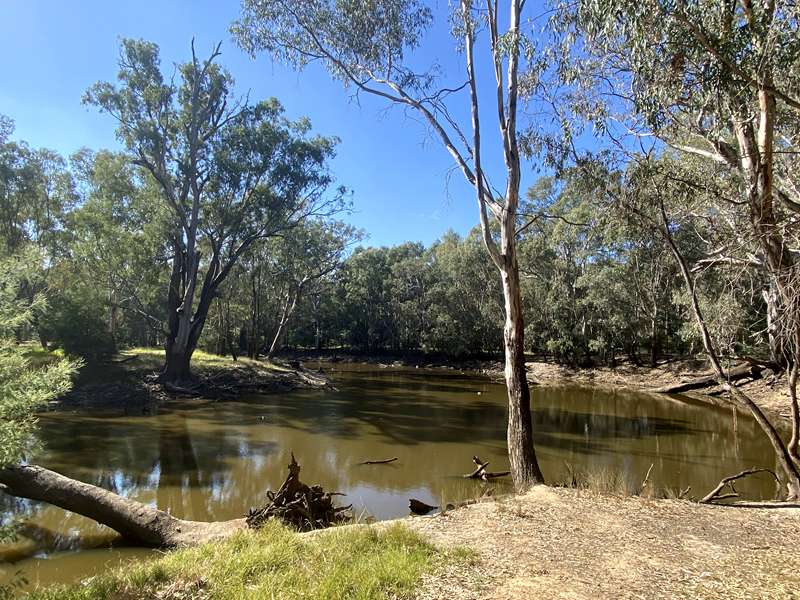
Mullinmur Billabong comprises approximately 20 hectares of floodplain riparian woodland on the Ovens River and is located 2.5 kilometres north of the Wangaratta City Centre. Mullinmur Billabongs is the traditional land of the Bpangerang. Mullinmur is from the Bpangerang language and means platypus. Platypuses are seen along this stretch of the Ovens River. Mullinmur Billabongs is privately owned land, open to public access.
There are two main walking tracks (1.4km) located around the billabongs, with picnic seating along the way.
Access to the area is via the corner of Phillipson Street and Cambridge Drive. The one mentioned here is the Billabong Loop. Also try the Torryong Track a little to the north.
The wetland vegetation of Mullinmur Billabong is dominated by River Red Gums, Silver Wattle, Black Wattle, Sedges, Knotweed and herbs including Joyweed, Sneezeweed, and Carpetweed.
Look out for a range of wetland and woodland birds and during the evening you may catch a glimpse of Barking Owls, Sugar Gliders and Possums emerging from the large old trees that provide hollows and food for many species.
Camping is not allowed and unauthorised campfires are prohibited. Be aware that older River Red Gum trees can be stressed in summer and drop large limbs. Also snakes, a vital and protected part of this ecological system, can be active all year, but particularly in the warmer months.
Map of Route
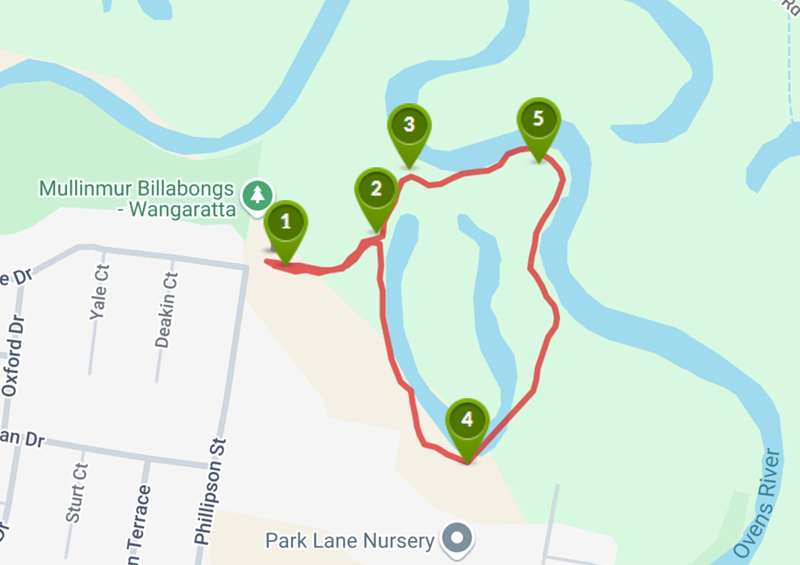
Interactive Map
Information Signage:
The Billabong Loop in particular has a number of information signs including:
Mullinmur Billabongs - Gateway to the Lower Owens River
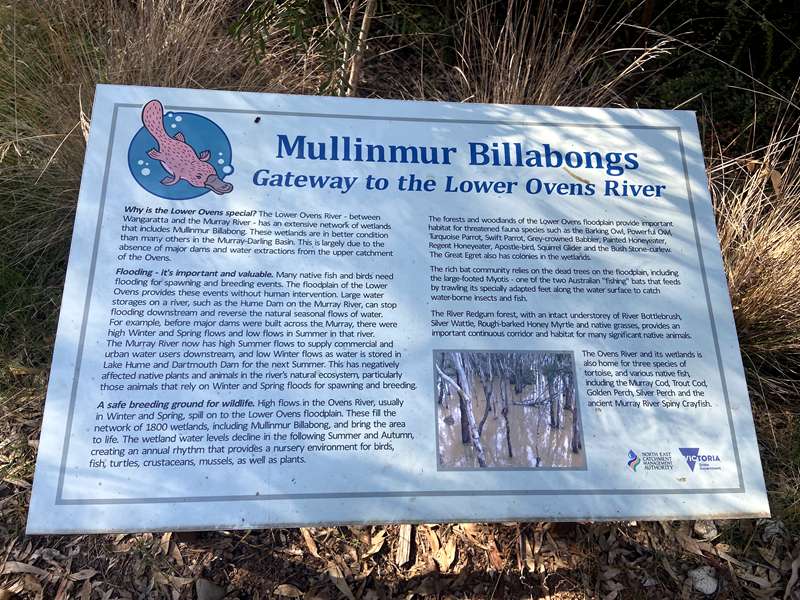
Why is the Lower Ovens special? The Lower Ovens River - between Wangaratta and the Murray River - has an extensive network of wetlands that includes Mullinmur Billabong. These wetlands are in better condition than many others in the Murray-Darling Basin. This is largely due to the absence of major dams and water extractions from the upper catchment of the Ovens.
Flooding - it's important and valuable. Many native fish and birds need flooding for spawning and breeding events. The floodplain of the Lower Ovens provides these events without human intervention. Large water storages on a river, such as the Hume Dam on the Murray River, can stop flooding downstream and reverse the natural seasonal flows of water. For example, before major dams were built across the Murray, there were high Winter and Spring flows and low flows in Summer in that river. The Murray River now has high Summer flows to supply commercial and urban water users downstream, and low Winter flows as water is stored in Lake Hume and Dartmouth Dam for the next Summer. This has negatively affected native plants and animals in the river's natural ecosystem, particularly those animals that rely on Winter and Spring floods for spawning and breeding.
A safe breeding ground for wildlife. High flows, in the Ovens River, usually in Winter and Spring, spill on to the Lower Ovens floodplain. These fill the network of 1800 wetlands, including Mullinmur Billabong, and bring the area to life. The wetland Water levels decline in the following Summer and Autumn, creating an annual rhythm that provides a nursery environment for birds, fish, turtles, crustaceans, mussels, as well as plants.
The forests and woodlands of the Lower Ovens floodplain provide important habitat for threatened fauna species such as the Barking Owl, Powerful Owl, Turquoise Parrot, Swift Parrot, Grey-crowned Babbler, Painted Honeyeater, Regent Honeyeater, Apostle-bird, Squirrel Glider and the Bush Stone-curlew. The Great Egret also has colonies in the wetlands.
The rich bat community relies on the dead trees on the floodplain, including the large footed Myotis - one of the two Australian "fishing" bats that feeds by trawling its specially adapted feet along the water surface to catch water-borne insects and fish.
The River Redgum forest, with an intact understorey of River Bottlebrush, Silver Wattle, Rough-barked Honey Myrtle and native grasses, provides an important continuous corridor and habitat for many significant native animals.
The Ovens River and its wetlands is also home for three species of tortoise, and various native fish, including the Murray Cod, Trout Cod, Golden Perch, Silver Perch and the ancient Murray River Spiny Crayfish.
Mullinmur Billabongs Nesting Box Program
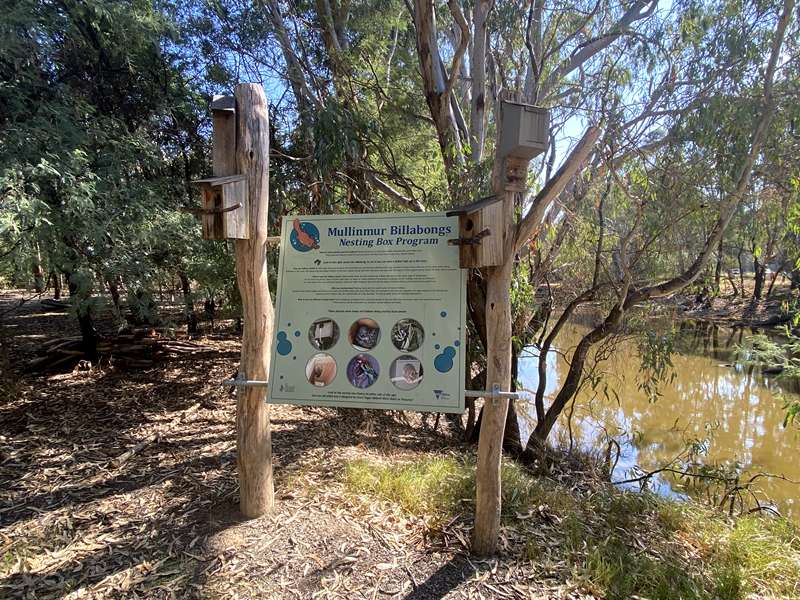
Why do native animals need tree hollows? Twenty percent of our Australian wildlife, including birds, don't build nests. They need tree hollows in which to nest and breed. The River Red Gums create many natural hollows.
How are hollows made? As trees age, they drop branches, the remaining tree scar becomes infested with fungi, termites or other insects that eat out the dead wood along branches or the trunk, this leaves long thick-walled hollows in the tree, a great nesting site! River Red Gums can take over 100 years to form a good nesting hollow for birds, bats or possums.
Where have the hollows gone? Unfortunately, there are few suitable tree hollows left here on the urban edge of Wangaratta. As the town has grown, many old trees have been cut down to create paddocks for grazing or cropping, and for building materials and firewood. As many older trees were removed between 1900 and 1980, Mullinmur lacks the normal range of hollows that an undisturbed forest would have.
Why use nesting boxes? Nesting boxes are now used in place of natural hollows. Students from Galen College and Borinya have built and installed boxes here since 2014. Boxes are maintained and observed regularly, and observations on the animals and numbers present entered into the national Atlas of Living Australia - an ever growing record of Australia's biodiversity.
Why do we use different nesting boxes? Each nesting box is designed for a particular animal or bird, but that does not always mean that animal lives there! There can be a lot of competition for nesting in natural hollows and boxes.
Mullinmur Billabongs Native Fish Nursery
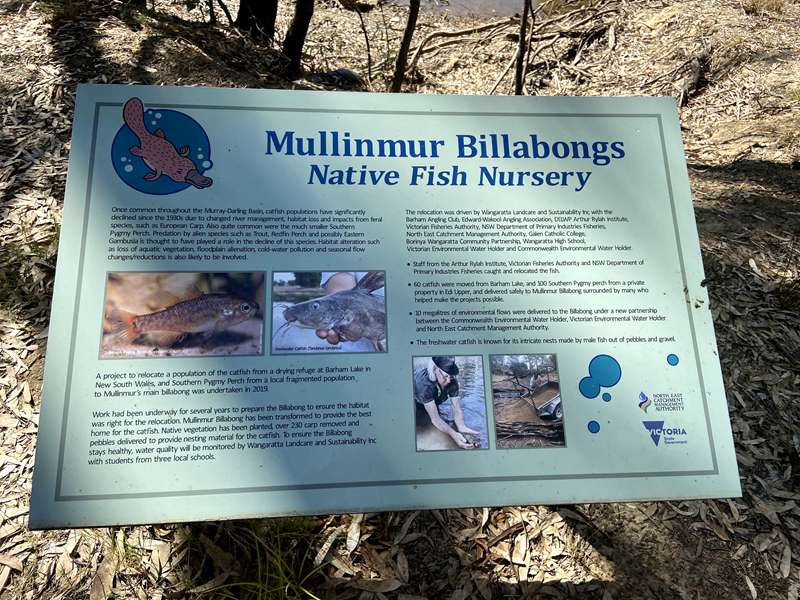
Once common throughout the Murray-Darling Basin, catfish populations have significantly declined since the 1930s due to changed river management, habitat loss and impacts from feral species, such as European Carp. Also quite common were the much smaller Southern Pygmy Perch. Predation by alien species such as Trout Redfin Perch and possibly Eastern Gambusia is thought to have played a role in the decline of this species. Habitat alteration such as loss of aquatic vegetation, floodplain alienation, cold-water pollution and seasonal flow changes/reductions is also likely to be involved.
A project to relocate a population of the catfish from a drying refuge at Barham Lake in New South Wales, and Southern Pygmy Perch from a local fragmented population to Mullinmur's main Billabong was undertaken in 2019.
Work had been underway for several years to prepare the Billabong to ensure the habitat was right for the relocation. Mullinmur Billabong has been transformed to provide the best home for the catfish. Native vegetation has been planted, over 230 carp removed and pebbles delivered to provide nesting material for the catfish. To ensure the Billabong stays healthy, water quality will be monitored by Wangaratta Landcare and Sustainability Inc with students from three local schools.
- Staff from the Arthur Rylah Institute, Victorian Fisheries Authority and NSW Department of Primary Industries Fisheries caught and relocated the fish.
- 60 catfish were moved from Barham Lake, and 100 Southern Pygmy perch from a private property in Edi Upper, and delivered safely to Mullinmur Billabong surrounded by many who helped make the projects possible.
- 10 megalitres of environmental flows were delivered to the Billabong under a new partnership between the Commonwealth Environmental Water Holder, Victorian Environmental Water Holder and North East Catchment Management Authority.
- The freshwater catfish is known for its intricate nests made by male fish out of pebbles and gravel.
Munanmur Billabongs- A Native Fish 'Shelter'
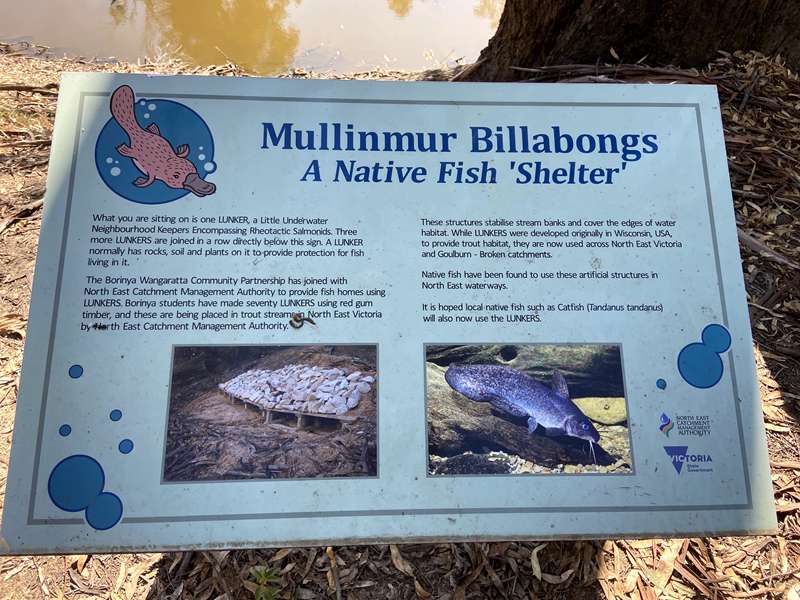
What you are sitting on is one LUNKER, a Little Underwater Neighbourhood Keepers Encompassing Rheotactic Salmonids. Three more LUNKERS are joined in a row directly below this sign. A LUNKER normally has rocks, soil and plants on it to provide protection for fish living in it.
The Borinya Wangaratta Community Partnership has joined with North East Catchment Management Authority to provide fish homes using LUNKERS. Borinya students have made seventy LUNKERS using red gum timber, and these are being placed in trout streams in North East Victoria by North East Catchment Management Authority.
These structures stabilise stream banks and cover the edges of water habitat. While LUNKERS were developed originally in Wisconsin, USA, to provide trout habitat, they are now used across North East Victoria and Goulburn - Broken catchments.
Native fish have been found to use these artificial structures in North East waterways. It is hoped local native fish such as Catfish (Tandanus tandanus) will also now use the LUNKERS.
River Red Gums - Eucalyptus camaldulensis
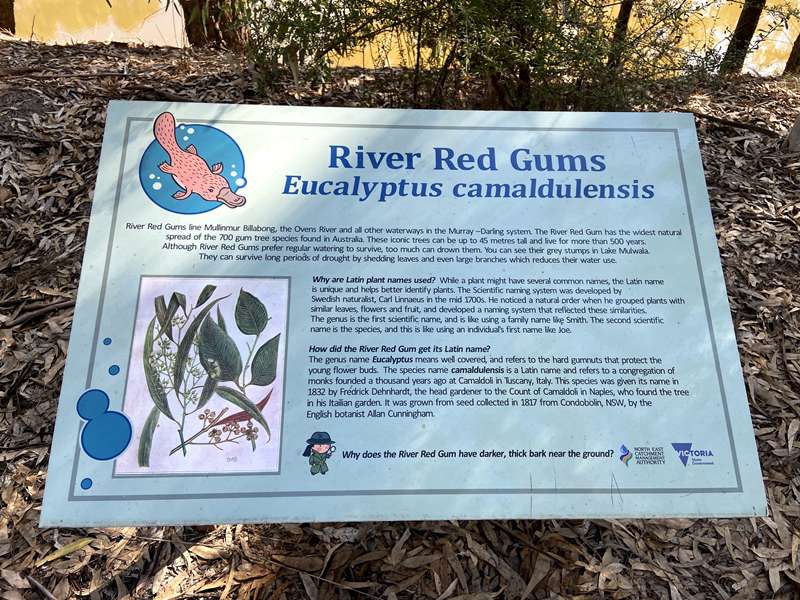
River Red Gums line Mullinmur Billabong, the Ovens River and all other waterways in the Murray-Darling system. The River Red Gum has the widest natural spread of the 700 gum tree species found in Australia. These iconic trees can be up to 45 metres tall and live for more than 500 years. Although River Red Gums prefer regular watering to survive, too much can drown them. You can see their grey stumps in Lake Mulwala. They can survive long periods of drought by shedding leaves and even large branches which reduces their water use.
Why are Latin plant names used? While a plant might have several common names, the Latin name is unique and helps better identify plants. The Scientific naming system was developed by Swedish naturalist Carl Linnaeus in the mid 1700s. He noticed a natural order when he grouped plants with similar leaves, flowers and fruit, and developed a naming system that reflected these similarities. The genus is the first scientific name, and is like using a family name like Smith. The second scientific name is the species, and this is like using an individual's first name like Joe.
How did the River Red Gum get its Latin name? T
The genus name Eucalyptus means well covered, and refers to the hard gumnuts that protect the young flower buds. The species name camaldulensis is a Latin name and refers to a congregation of monks founded a thousand years ago at Camaldoli in Tuscany, Italy. This species was Oven its name In 1832 by Fredrick Dehnhardt, the head gardener to the Count of Camaldoli in Naples, who found the tree in his ltailian garden. It was grown from seed collected in 1817 from Condobolin, NSW, by the English botanist Allan Cunningham.
Mullinmur Billabongs - Constructed Wetlands
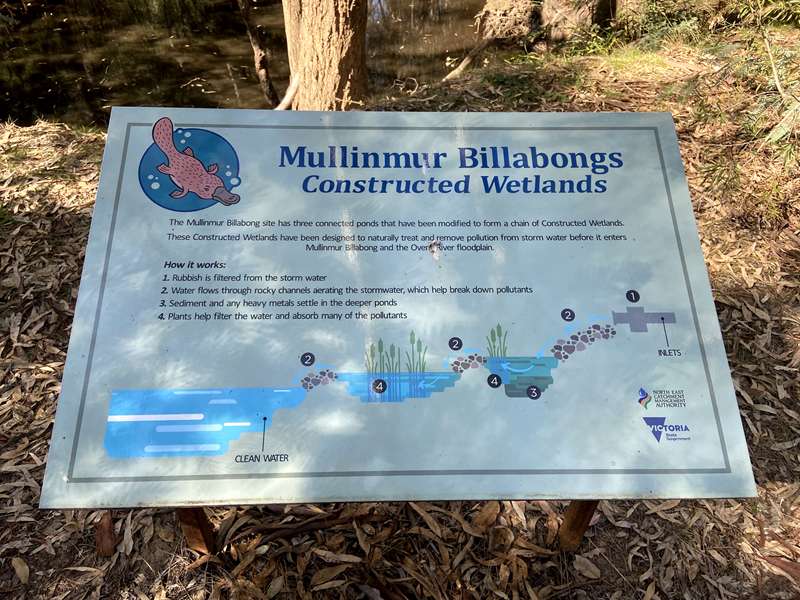
The Mullinmur Billabong site has three connected ponds that have been modified to form a chain of Constructed Wetlands. These Constructed Wetlands have been designed to naturally treat and remove pollution from storm water before it enters Mullinmur Billabong and the Ovens River floodplain.
How it works:
1. Rubbish is filtered from the storm water.
2. Water flows through rocky channels aerating the stormwater, which help break down pollutants.
3. Sediment and any heavy metals settle in the deeper ponds.
4. Plants help filter the water and absorb many of the pollutants
Fishing:
Fishing is permitted in the Ovens River but fishing is not permitted in the billabongs as they are native fish nurseries.
Access for Dogs:
Dog walkers need to be responsible for dogs off the lead.
Review:
This is a wonderful walk which is best combined together with the Mullinmur Billabong Torryong Track to create a walk which passes through a number of different environments.
There is a small carpark at the corner of Phillipson Street and Cambridge Drive. Head past the locked gate and after about 100m you will come to a T-intersection where the following map is displayed.
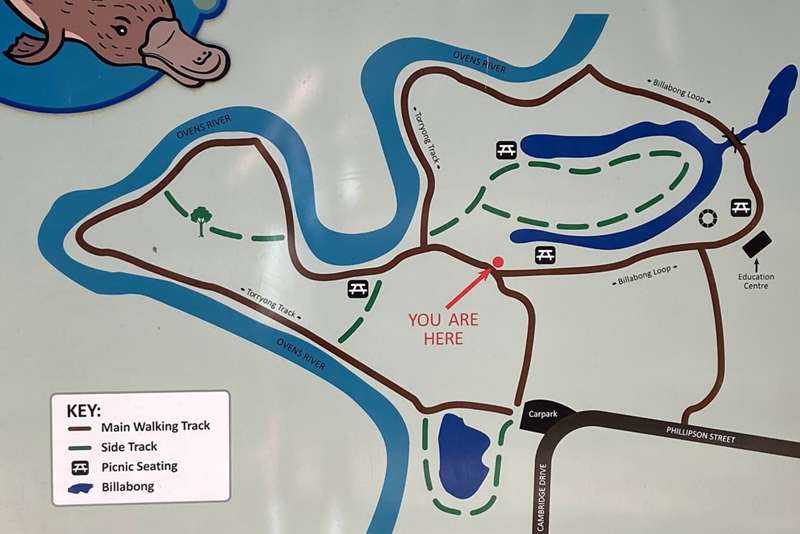
At the T-intersection, we turned right and followed the Billabong Loop which arcs around the billabong area. The track has a billabong on one side with lots of information signs about the environment. It passes an Education Centre where there is a platform with seats under umbrellas, outdoor circular seating, firepit and two shaded tables.
The Billabong Loop then joins the Torryong Track which runs beside the twisting Ovens River before coming back to the carpark. Near the carpark the track passes the Phillipson Wetland Flora & Fauna reserve.
The whole area has a huge number and variety of different birds including lots of colourful parrots.
Photos:
Location
Cnr Phillipson Street and Cambridge Drive, Wangaratta 3677 View Map
Web Links
→ Mullinmur Billabong Loop (Walking Maps)








